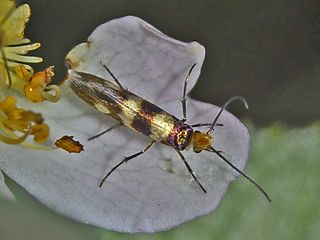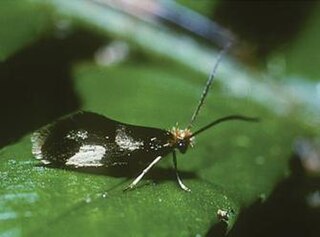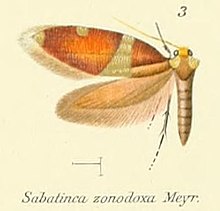Agathiphaga is a genus of moths, known as kauri moths. It is the only living in the family Agathiphagidae. This caddisfly-like lineage of primitive moths was first reported by Lionel Jack Dumbleton in 1952, as a new genus of Micropterigidae.

Micropterix aureatella is a moth of the family Micropterigidae found in the Palearctic realm, except for North Africa.

Micropterix calthella, the marsh marigold moth, is a species of moth belonging to the family Micropterigidae. It is found in damp habitats throughout Europe and is also distributed eastwards to central Siberia. It was first described by Carl Linnaeus in 1761 as Phalaena calthella.

Micropterix aruncella is a species of moth belonging to the family Micropterigidae, which is distributed throughout Europe. The imago was first described by Giovanni Antonio Scopoli in 1763. This species is one of the best known members of the family, being found in a wide range of habitats from sea level to over 2,000 metres (6,600 ft); the only habitat not favoured by this species is dense woodland.

Micropterix tunbergella is a moth of the family Micropterigidae found in most of Europe. The moths are very small and can be found feeding on the pollen of hawthorn, oak and sycamore. The larva and pupa are unknown. The moth was described Johan Christian Fabricius in 1787.

Micropterix allionella is a moth of the family Micropterigidae. It was described by Johan Christian Fabricius in 1794.
Micropterix facetella is a species of moth belonging to the family Micropterigidae, which was described by Zeller in 1851. Micropterix facetella has a 4 male facetalla to 1 female facetalla ratio and during the mating season female facetella are said to visit a flower, only to eat, and the male facetella are there for the purpose to mate. For the common ratio, the male facetella goes to a near by location that another male facetella was already there as a pursuit of competition. A competition on who will get the female first, which is why there is 4 males facetalla for every 1 female facetella. It is known from Croatia and Slovenia.
Micropterix fenestrellensis is a species of moth belonging to the family Micropterigidae. It was described by John Heath and T. Kaltenbach in 1984. It is known from Italy.
Tasmantrix is a genus of small primitive metallic moths in the family Micropterigidae.
Austromartyria porphyrodes is a moth of the family Micropterigidae. It is only known to be from the higher rainfall regions of the Atherton Tableland in northern Queensland.
Tasmantrix lunaris is a moth of the family Micropterigidae. It is known from eastern Australia, where it is known from two localities in the southern coastal forests of New South Wales.
Tasmantrix phalaros is a moth of the family Micropterigidae. It is known from eastern Australia, in wet, upland eucalypt forests of northern New South Wales from Minyon Falls to Narara.
Nannopterix choreutes is a moth of the family Micropterigidae. It is known from New Caledonia, from the Table Unio south to Rivière Bleue.

Baltimartyria is an extinct genus of primitive metallic moths in the family Micropterigidae. The genus is solely known from the Early Eocene Baltic amber deposits in the Baltic Sea region of Europe. The genus currently contains two described species, Baltimartyria proavitella and Baltimartyria rasnitsyni.
Micropterix rablensis is a species of moth belonging to the family Micropterigidae, which was described by Philipp Christoph Zeller in 1868. It is probably restricted to Carinthia in Austria and to the adjacent areas of Styria in Austria and Italy and potentially of Slovenia. Its Croatian, Romanian and French existence is doubtful.

Sabatinca is a genus of small primitive metallic moths in the family Micropterigidae. Palaeomicra and Micropardalis were both established as subgenera of Sabatinca, but were both raised to generic level by Joël Minet in 1985. However, in 2014 both these genera, Palaeomicra and Micropardalis, were recognised by George Gibbs as synonyms of Sabatinca. Extinct species in this genus are known from the Cretaceous Burmese amber.

Epimartyria pardella is a species of moth belonging to the Micropterigidae family. It was described by Walsingham, Lord Thomas de Grey, in 1880. Its wingspan is 10–11 mm with a metallic brown forewing featuring three distinctive gold spots. Adults are on wing from early May to mid July and are day active. The larvae feed on liverworts, including Conocephalum conicum and Pellia species and take about two years to fully develop.
Squamicornia aequatoriella is a species of moth belonging to the family Micropterigidae. It was described by Kristensen & Nielsen in 1982. It is known from the Napo province in Ecuador.
Vietomartyria expeditionis is a species of moth belonging to the family Micropterigidae. It was described by Wolfram Mey in 1997. It is known from the mountainous areas of northern Vietnam.

Micropterigoidea is the superfamily of "mandibulate archaic moths", all placed in the single family Micropterigidae, containing currently about twenty living genera. They are considered the most primitive extant lineage of lepidoptera, and the sole superfamily in the suborder Zeugloptera. The name comes from the Greek for mikros, little and pterux, a wing. Unique among the Lepidoptera, these moths have chewing mouthparts rather than a proboscis, and are seen feeding, often in large aggregations, on the pollen of the flowers of many herbaceous plants, shrubs and trees. The fossil record of the group goes back to the middle-late Jurassic with the earliest known species being Auliepterix from the Karabastau Formation in Kazakhstan.









